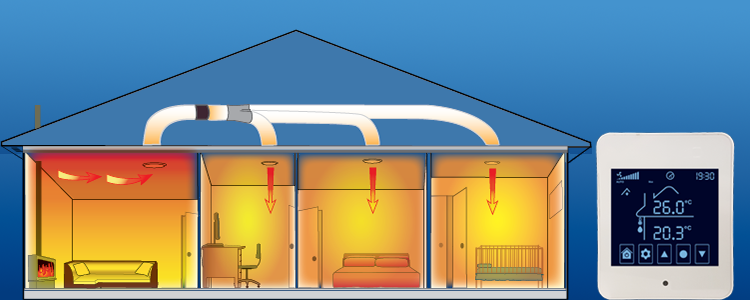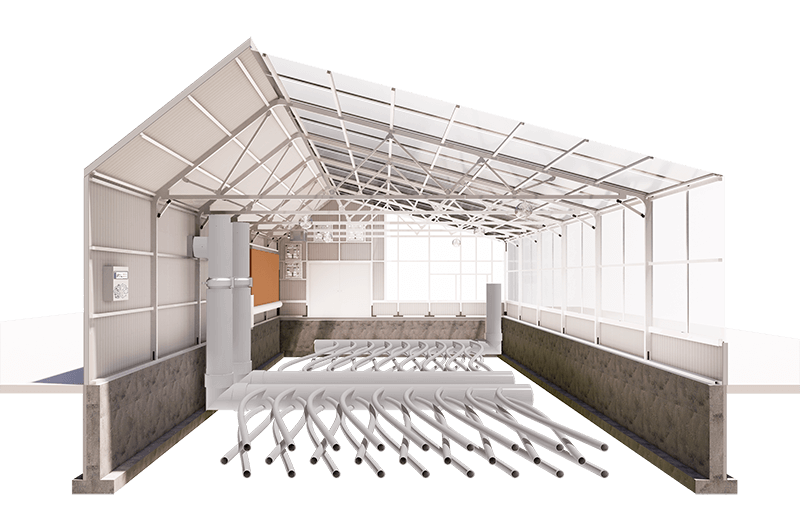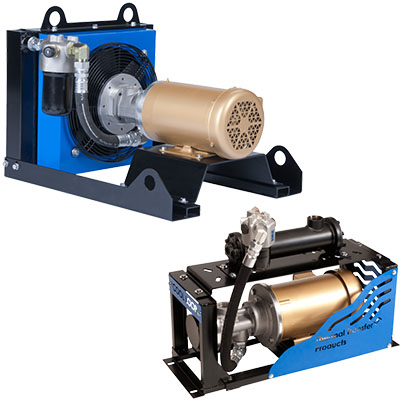A Deep Dive into Advanced CFD Modeling in DVS Heat Transfer Systems
Wiki Article
The Role of Heat Transfer Equipments in Sustainable Energy Solutions for the Future
Heat transfer systems are crucial in the quest for lasting energy solutions. They maximize thermal energy management, enhancing the effectiveness of eco-friendly innovations. By using devices like transmission, convection, and radiation, these systems lessen power losses. Their duty in solar thermal and geothermal applications is specifically substantial. As developments emerge, the possibility for further advancements increases vital concerns regarding future power strategies. What developments will shape the landscape of lasting power?Comprehending Heat Transfer Equipments

The Significance of Thermal Energy Management
Reliable thermal power management is important for maximizing power performance and decreasing waste in numerous systems. By controling temperature level and optimizing Heat transfer processes, companies can substantially minimize power intake and operational costs. Effective administration includes the execution of innovative technologies and methods that monitor and manage thermal conditions within systems, ensuring that power sources are made use of efficiently. On top of that, appropriate thermal power administration adds to lowering greenhouse gas emissions, straightening with worldwide sustainability goals. It additionally improves system dependability and performance, resulting in improved item high quality and longer tools life expectancy. Eventually, focusing on thermal power monitoring is a vital action towards creating much more sustainable power options and promoting a liable approach to energy intake in residential and industrial contexts.Applications of Heat Transfer in Renewable Resource
While numerous eco-friendly power resources guarantee sustainability, the reliable application of Heat transfer plays an important role in their efficiency. In wind power systems, Heat transfer is used for turbine component cooling, boosting performance and durability. Geothermal power depends on efficient Heat exchange in between the planet's subsurface and the liquid circulating in the system, making best use of power removal. Biomass power processes likewise profit from Heat transfer, as it helps in transforming natural materials right into useful gas with pyrolysis and gasification. In addition, in hydropower, maintaining suitable temperature levels in reservoirs can improve power output. Each of these applications demonstrates the vital importance of Heat transfer systems in enhancing sustainable energy technologies, eventually adding to a much more sustainable power future.Enhancing Solar Thermal Power Efficiency
As solar thermal power systems remain to develop, boosting their efficiency has actually ended up being important for making the most of power output. Advances in Heat transfer technologies, such as improved thermal storage products and innovative Heat exchangers, play a significant function in enhancing efficiency. By utilizing innovative materials that have premium thermal conductivity, systems can transfer and capture Heat better. In addition, incorporating monitoring systems that adhere to the sun's course warranties that enthusiasts obtain excellent solar exposure throughout the day. Using nanotechnology in solar absorbers can even more increase energy absorption rates. Furthermore, integrating automatic control systems helps take care of and manage temperature levels power circulation effectively, causing reduced losses and enhanced general system performance. These enhancements lead the means for more sustainable solar thermal energy options in the future.Geothermal Heating: A Sustainable Remedy
Geothermal heating presents a viable choice for sustainable energy, using significant ecological benefits through minimized greenhouse gas exhausts. Its effectiveness and cost-effectiveness make it an attractive option to standard furnace. Nevertheless, obstacles connected to execution must be dealt with to maximize its possible effect.Environmental Advantages of Geothermal
Although traditional heating approaches contribute substantially to greenhouse gas discharges, geothermal heating provides an engaging option that minimizes environmental impact. By harnessing the Planet's inner Heat, geothermal systems use a renewable resource source, substantially lowering dependence on fossil gas. This method creates very little carbon discharges, making it a cleaner choice for business and property heating. Additionally, geothermal systems promote energy performance, as they need less power compared to conventional heater. DVS Heat Transfer Systems. The usage of geothermal energy likewise assists in decreasing air pollution, boosting regional air quality and public health. As a lasting service, geothermal home heating supports climate modification mitigation efforts, positioning itself as a crucial part in the shift towards a greener futureEffectiveness and Cost-Effectiveness
Exactly how does geothermal home heating determine up in regards to effectiveness and cost-effectiveness contrasted to standard home heating systems? Geothermal heating demonstrates exceptional efficiency, commonly achieving a coefficient of efficiency (POLICE) of 3 to 5, indicating it produces three to five systems of Heat for each device of electrical power consumed. This effectiveness equates into lower operating prices, especially in areas with steady geothermal resources. Initial setup prices can be greater than standard systems; nevertheless, long-term savings on energy bills and reduced maintenance expenditures can offset these in advance financial investments. Additionally, lots of federal governments incentivize geothermal systems through rebates and tax credit scores, boosting their cost-effectiveness. In general, geothermal heating arises as a financially sensible and lasting alternative to more conventional heating services.Implementation Difficulties and Solutions
Many difficulties can hamper the prevalent execution of geothermal heating unit, regardless of their clear benefits as a sustainable energy service. High preliminary setup expenses commonly hinder property owners and financiers, making funding a considerable barrier. In addition, the geographical restrictions of suitable geothermal sites limit access in specific regions. Local laws and permitting procedures can also make complex job growth, leading to delays. Public understanding and understanding of geothermal systems continue to be low, hindering approval. To resolve these difficulties, targeted education projects can boost open secret, while government incentives can alleviate economic concerns. Collaborating with neighborhood authorities to improve laws may facilitate smoother task approvals, inevitably advertising the adoption of geothermal home heating as a practical, sustainable power option.Advancements in Heat Transfer Technologies
Advancements in Heat transfer modern technologies play a vital duty in enhancing power efficiency and sustainability. Advanced Heat exchangers and phase modification products are at the center of these advancements, supplying considerable renovations in thermal management. These modern technologies not only maximize energy use but likewise add to decreasing ecological impact in various applications.Advanced Heat Exchangers
Advanced Heat exchangers play an important DVS Heat Transfer Systems function in boosting energy effectiveness throughout numerous applications in sustainable energy options. These tools help with the transfer of Heat in between 2 or even more liquids, substantially reducing energy usage in procedures such as commercial home heating, air conditioning, and power generation. Innovations in materials and style, such as making use of nanofluids and portable configurations, have caused boosted thermal efficiency and reduced size demands. Furthermore, improvements in electronic surveillance and control systems permit enhanced procedure, more raising performance. By minimizing waste Heat and optimizing power recuperation, advanced Heat exchangers add to lower carbon impacts and sustain the change towards ecologically friendly innovations. Their continued advancement is important for achieving global energy sustainability objectives.
Phase Modification Materials
The assimilation of phase change materials (PCMs) into Heat transfer modern technologies stands for a substantial advancement in power administration and performance. PCMs soak up and release thermal energy throughout their stage modifications, enabling effective temperature level law in structure materials and power systems. By saving excess Heat during optimal periods and releasing it when need boosts, PCMs add to pack shifting and power preservation - DVS Heat Transfer Systems. This capability boosts the efficiency of sustainable power systems, particularly in solar thermal applications. In addition, PCMs can enhance the thermal comfort of interior environments, decreasing dependence on traditional home heating and cooling down approaches. As technologies in PCM formulas proceed to emerge, their duty in sustainable power services is positioned to grow, supplying appealing avenues for future study and application
Future Potential Customers for Heat Transfer in Sustainable Energy
As the demand for lasting energy services remains to rise, the role of Heat transfer systems is coming to be significantly vital fit future innovations. Advancements in materials and designs are anticipated to improve performance in Heat transfer, decreasing power losses in different applications. The integration of sophisticated thermal storage systems, such as stage modification materials and thermochemical storage, will certainly allow much better monitoring of power resources. Research right into nanofluids and biomimetic Heat exchangers may better enhance thermal performance. The adoption of clever innovations will enable for real-time monitoring and flexible control of Heat transfer procedures. These developments are poised to substantially add to the total efficiency and sustainability of energy systems, leading the way for an extra energy-efficient future.Often Asked Questions
Exactly How Can Individuals Carry Out Heat Transfer Equipment at Home?

People can execute Heat transfer systems in your home by setting up energy-efficient appliances, making use of radiant heat, and maximizing insulation. These procedures boost energy performance, decrease prices, and promote sustainable techniques in domestic settings.

What Are the Expenses Related To Installing Heat Transfer Equipments?
The expenses related to installing Heat transfer systems vary widely, usually incorporating devices, installation labor, and upkeep. Aspects such as system type, home size, and local laws significantly influence the total expense involved.Exist Government Incentives for Heat Transfer System Installations?
Government motivations for Heat transfer system installments differ by region and can consist of tax rebates, credits, and gives. These economic benefits intend to urge adoption, inevitably promoting power effectiveness and lowering ecological effect within areas.How Do Heat Transfer Equipments Impact Power Bills?
Heat transfer systems especially influence power bills by enhancing power efficiency. By enhancing the transfer of Heat, these systems reduce energy usage, leading to lower energy prices and creating a much more lasting approach to energy administration.What Upkeep Is Needed for Heat Transfer Solutions?
Maintenance for Heat transfer systems includes routine examinations, cleaning of components, inspecting liquid levels, making sure proper insulation, and replacing worn parts. These tasks assist preserve performance, stop breakdowns, and extend the system's operational life expectancy.These systems promote the activity of thermal power from one tool to an additional, making it possible for the transfer of Heat for home heating, air conditioning, or power generation objectives. Geothermal power counts on reliable Heat exchange in between the planet's subsurface and the fluid distributing in the system, optimizing power extraction. Furthermore, geothermal systems promote energy efficiency, as they require much less power contrasted to traditional heating systems. Advanced Heat exchangers play an important role in enhancing energy efficiency throughout numerous applications in lasting energy solutions. Heat transfer systems especially affect power expenses by optimizing power effectiveness.
Report this wiki page